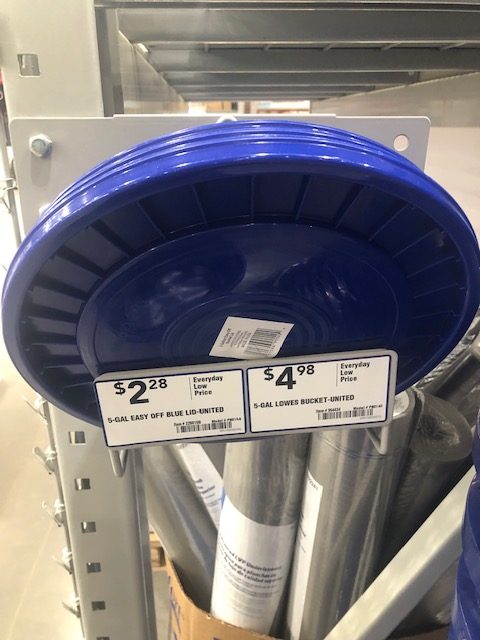I am not the handiest man. I like to spend my days inside my circles of competence, and none of those circles currently involve a circular saw. That’s not to say that with years of practice, hours on YouTube and some serious work I couldn’t get there, but for the past 10 years my “tool box” has been an old Mac laptop box full of screws and a hammer. In this environment, where help and contractors are hard to find, I’ve been forced to tackle a couple of small projects, which led me to Lowes. I was on a specific mission to get some sandpaper and a couple other items, and there on the end of the row was a blue Lowes bucket. Since all my buckets have been pirated by my children for mud stew or half filled with rotten apples, I figured now was the perfect time to expand my toolbox with a nice utility bucket. I grabbed the bucket, looked at the price, and then had a very Jerry Seinfeld moment of pure and utter annoyance. The price for the bucket was $4.98 – not bad, until I saw that the lid was sold separately for an additional $2.28! Small thing, yes, but it led me down a decision tree that I felt was totally unnecessary. First, I thought the bucket/lid was a single item, not something that required an additional decision/purchase. Second, the lid costs 50% as much as the bucket. My financial planner brain started doing the math and wondering, regardless of price, is the lid really worth half as much as the entire bucket? What scenarios am I going to face where I will regret not buying the lid too? In the end, I took a picture of the price tag so I could at least write this post, left and bought a bucket (no lid) at Home Depot a week later. 😊
This consumer-driven landscape, with an abundance of options and choices, is only growing larger. Want to buy a refrigerator? It’s no longer a coin toss decision nor does it come down to whether I want to spend a lot or a little. It comes down to 37 different makes/models with different bells and whistles, and this decision dilemma flows right on into your financial plan. Want to save for retirement? There are 19 different ways to go about it and that decision doesn’t account for the next investment decision you need to make, where the world of possibilities enters the thousands. This complexity, this freedom of choice is at first a wonderful blessing as it helps to spur competition, innovation and drive down prices. Yet at a point, it also creates so many decisions that your margin for error starts to grow, and along with it, your confidence about making a solid decision begins to fall. Instead of saving for retirement, you bookmark the website of the article you read and will get back to it tomorrow. Instead of calling the attorney, sitting down and getting the Will done, you leave the list of three names on the fridge for a year until it unknowingly falls off. To make any progress, you’re left with trying to do the work/research yourself, doing nothing, or finding a trusted professional to help guide you along the way and curate your options for you. This is the job of any professional, and in my case the first job of the financial planner. A profession that, 30 years ago, was tasked with simply picking a good stock or two has evolved into being responsible with helping you decide what decisions are even worth making in the first place. If you’re unsure how big your retirement bucket needs to be, or if you need a retirement bucket at all, I am here to help. Just please don’t bring up the lid.
Happy Friday! Please stay healthy and be safe!

